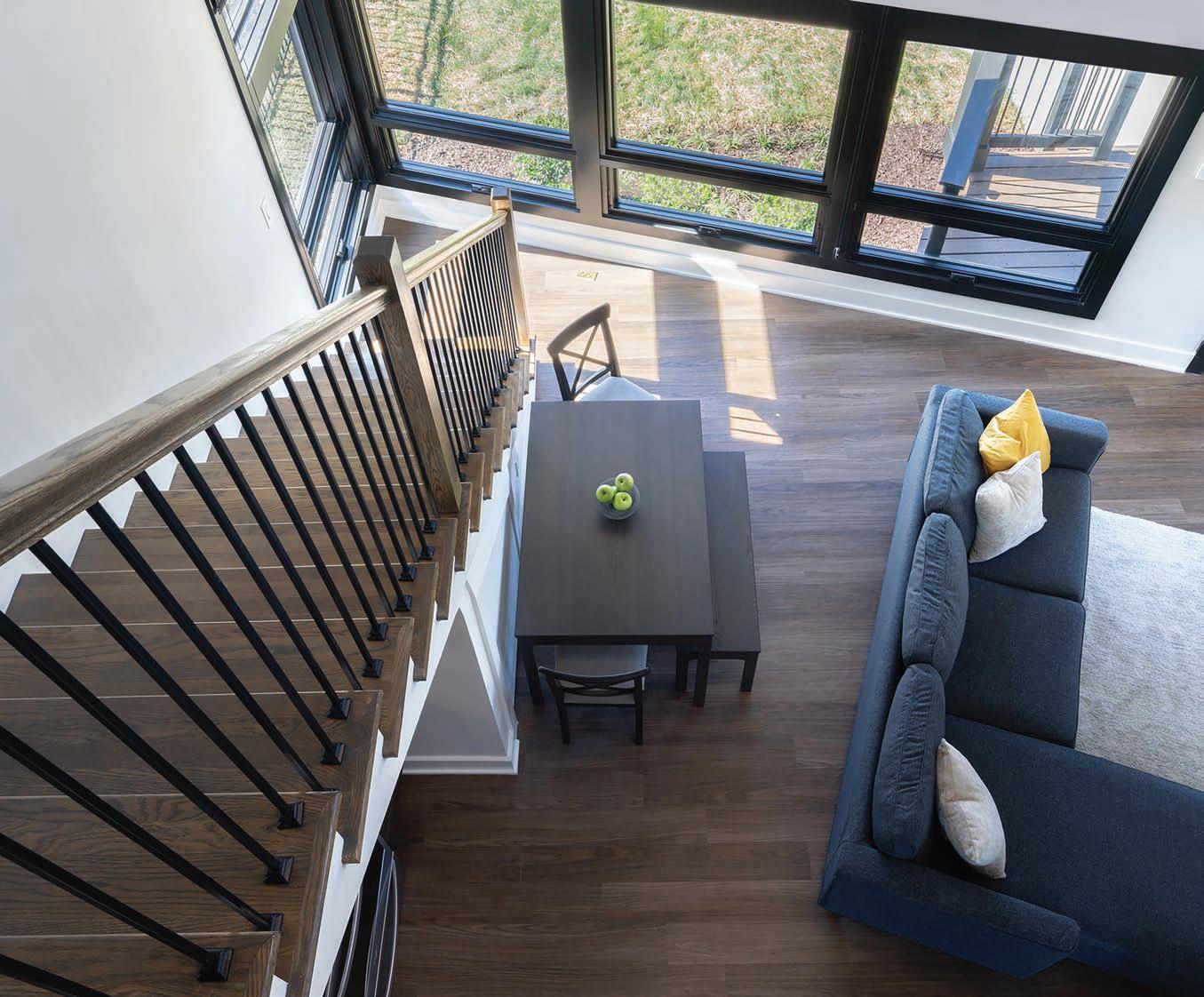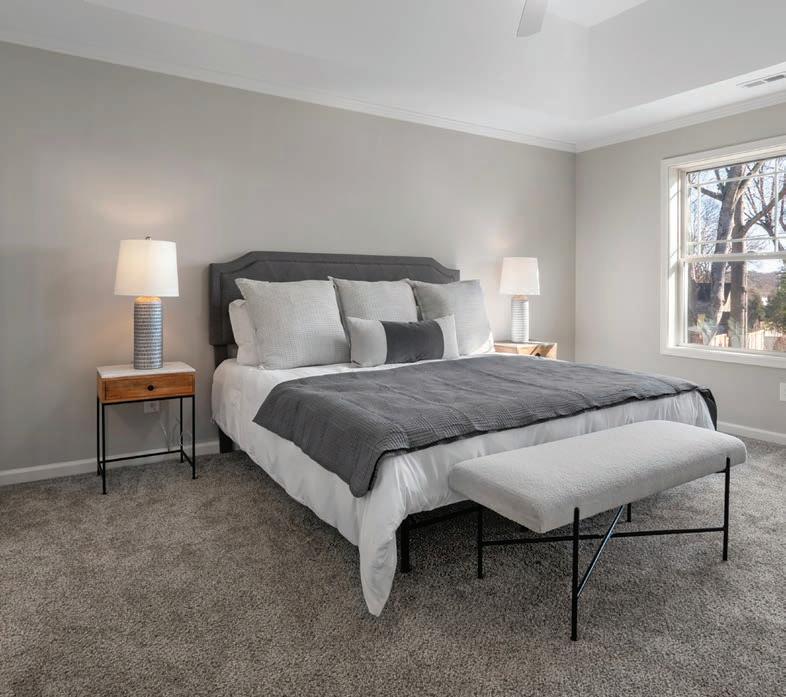
11 minute read
Building Community
BUILDING COMMUNITY
TRIO WORK TOGETHER TO CREATE HOUSING THAT IS BEAUTIFUL AND ATTAINABLE
BY HOLLIE DEESE | PHOTOGRAPHY BY WILLIAM DESHAZER AND AMIR AGHAREB

April was National Fair Housing Month, a recognition of the passage of the Fair Housing Act in 1968 and a recommitment to the fight for housing justice. The landmark law was meant to end housing discrimination and segregation, but more than 50 years later, communities of color still face disinvestment and a lack of access to opportunity due to policies rooted in that same history of exclusion.
Working toward housing equality and helping all people achieve homeownership has been a driving force for Marshall Crawford for years.
Originally from Philadelphia, Crawford spent five years in the military stationed at Fort Knox, Kentucky. After graduating from Western Kentucky University, Crawford moved to Nashville in 1995 to start his banking career with SunTrust. He eventually became a mortgage loan officer and became enamored with providing people the opportunity to create wealth through homeownership.

“When I was in college, I did a senior thesis on disparities in mortgage lending, where African Americans and Hispanics were only told the rules about mortgage lending, but they were never told the exceptions to the rules,” he says. “I always wanted to be a person who conveyed the exceptions in addition to the rules around mortgage lending.”
Crawford was a mortgage loan officer for a number of years before becoming a bank examiner. From that experience, he learned about banking from a regulatory standpoint.
“It gave me a clear understanding of the banking process, which led to me eventually working for a nonprofit consultant firm for 13 years — where I helped create lending processes that created home ownership opportunities for low- to moderate-income individuals,” he says.
Those opportunities included down payment assistance and help with closing costs.
“Being able to get those resources provides a lot of opportunities for individuals to become homeowners,” he says. “Education is critical, because the largest asset that most people will ever buy is a home.”
Many of those new homeowners had come from a childhood of renting, and Marshall was able to help them think about money and assets in a different way.
This development represents more than just bricks and mortar. It symbolizes our shared commitment to creating inclusive communities where individuals and families can thrive. Together, we are laying the foundation for a brighter future for Middle Tennessee. – Amani Kelly
“It’s the primary wealth for a lot of people, and making sure they utilize that house in the right way allows them to generate the wealth that they need to be able to send their kids to college, or to know that they’re leaving an asset behind to their heirs,” Crawford says. “When I eventually became a homeowner, I realized that it was the educational component that made a difference in my life — and could make a difference in so many other people’s lives as well.”
It was through this work that Crawford was introduced to The Housing Fund — and eventually became the CEO. The Housing Fund was created in 1996 in response to the affordable housing crisis in Nashville, when homes were significantly less expensive than today, as identified by the Nashville Next initiative.
Four banks came together to provide a $100,000 investment to create The Nashville Housing Fund, which eventually became a community development financial institution, connecting resources at the federal level to be able to provide down payment assistance and closing cost capital.

In 2004, The Housing Fund had an opportunity to help create an economic infusion into the Gulch and partnered with Market Street Enterprises to create Laurel House, now known as Owens Place on Laurel, which is 48 units of affordable housing in the Gulch, before the Gulch became what we know it to be today.
Once local only to Nashville, The Housing Fund has expanded its reach. In 2010 it also started providing capital to developers who offered to build affordable housing stock, but who needed capital to be able to create the supply.
After the historic flooding across Middle Tennessee in May of that year, The Housing Fund worked with a consortium of nonprofits and helped secure more than $30 million to help homeowners rebuild, restore and rehab their properties — and find new properties if they weren’t able to rebuild.
Crawford came on board in 2017, and that was when they were awarded Nashville’s very first Community Land Trust. Managed by The Housing Fund, the trust helps low- to moderate-income people buy a residence on land owned by The Housing Fund, so that home will always be affordable.
“When I joined The Housing Fund, we had about $21 million in total assets,” he says. “Today, we have about $53 million in total assets, with numerous products that provide an opportunity for individuals to still be able to purchase homes through our shared equity program, our normal down payment assistance and the Community Land Trust.”
Crawford says they were recently able to partner with two other nonprofits to acquire 54 acres of land in the Antioch area on which they will build more than 150 units of market rate and affordable housing. In that particular community, they have partnered with developers who want to build affordable housing. “So they utilize our capital, and we’re able to provide them with an investment that allows them to be able to build it and keep it at an affordable rate,” he says.
The Housing Fund has grown from those four initial banks to have 26 investment partners; Truist and Pinnacle are the largest. And they continue to grow relationships with strategic partners, developers and investors in new properties.
Amani Kelly, CEO of Southeast Investment Capital Group, and Keith Samaroo, CEO of Samaroo Group, are collaborating with Crawford on the development of a groundbreaking new construction project in Clarksville — Echelon Preserve off 101st Airborne Parkway.
“Projects like Echelon Preserve come to life through collaboration,” says Julia Sellers, cofounder of Southeast Investment Capital Group. “We are grateful for the support of city and county leaders, community partners, and organizations like The Housing Fund, who share our passion for creating meaningful housing solutions.”
The 120-unit townhome community will be tailored to meet the area’s housing needs. The venture marks a significant


The difference in this project is that it’s actually a community. — Shannon Heim
a real a paradigm shift for the city of Clarksville, because we’re providing quality housing for younger families that plan on living there for the longer duration.”
Crawford says this, like all of the properties they work on, are constructed to look like market-rate homes.
“You would never even know that they were considered affordable housing,” Crawford says. “And that’s what I think is important for us today, is to provide a product out there that looks no different than any other home. Low- to moderate-income individuals deserve a safe, solid and marketable product house just like anybody does. A lot of times when we look at the growth of the city, we forget about the fabric of the communities that make up that city. With The Housing Fund, we are always looking for the community and keeping the core fabric of what they are built on by making sure we provide housing opportunities, whether multifamily or single-family homes, that keep the character of the communities.”
Broker Shannon Heim, along with Jenn Ross, of The Heim Group and Keller Williams, say this kind of housing is very much needed in the city of

Clarksville, which, according to census estimates, is on track to reach a population of 200,000 by 2028 — double what it was in 2000. Clarksville is the county seat of Montgomery County, which already has a total population of about 240,000.
“The difference in this project is that it’s actually a community,” Heim says. “When you look at comparable properties, they don’t have the amenities or the all-inclusive ‘live work, play’ feel this has. That is a differentiator with this project versus any other multifamily development.”
Heim says the project’s amenities like the pool, walking trails, dog washing station and community center, along with its location and design, are key to making it a community.
“I think for the price point, this will be a very well-received project from the community,” Heim says.
Ground was broken on the McCormick Lane project in June 2024, and plans call for it to go vertical this June. Samaroo says the project will be done in three phases, starting with 2030 units.
“When I came to New York as a kid, I lived in an apartment in the Bronx, in a mixed income community, with folks anywhere from market rate to rent stabilized to senior citizens, to veteran housing, all in one building,” Samaroo says. “And if it wasn’t for that community when we came here as immigrants, we would have had no place to live. So for me, it’s always been a drive to create housing that was attainable for all income levels.”
And a diverse housing stock is needed for a city to thrive.
“This development represents more than just bricks and mortar,” Kelly says. “It symbolizes our shared commitment to creating inclusive communities where individuals and families can thrive. Together, we are laying the foundation for a brighter future for Middle Tennessee.”
Kelly is originally from Salem, Massachusetts, and moved to Nashville in January 2017. He took a job to help a company
he was working for open an office. But after his two years were up, he was ready for something else.
“I’m a recovering corporate guy,” he says.
He switched to real estate investment, drawing on his experience flipping properties in Salem — though breaking into the Nashville market was not as easy as he had anticipated.
“It took me two years to get into the market because there was so much competition,” Kelly says. “But I knew that I wanted to continue in real estate in some capacity. I didn’t know it would turn into being a developer.”
Kelly says he has learned a lot since he started developing, as far as what is good design, how to be cost-effective, and knowing what people look for. But now he sees his mission getting deeper and stronger.
“From a personal perspective, I was never supposed to be where I am today, just based off being raised by a single mother and some trouble I may have gotten into when I was younger,” Kelly says. “I’m just happy and blessed to be where I’m at today, to have the business relationships I do to work on projects like this, developing a diversity of thoughts. I think it’s important to have different faces in these rooms when dealing with the mayor, the county, the city, the planning department, the state, combining our strengths to benefit the people who actually live in the community.”
After all, everyone starts somewhere, and when a community invests in its people, the people tend to stay and give back.
“Low to moderate doesn’t mean no income. It just means not enough income,” Crawford says. “Once upon a time, I was a low- to moderate-income individual. I have been able to get to a certain level because of the education that I gave myself. My mom never owned a home, so why wouldn’t I try to help somebody else’s mom own a home? My significant contribution is providing opportunities for individuals to live a beautiful life. And it all starts with their home.” NI












